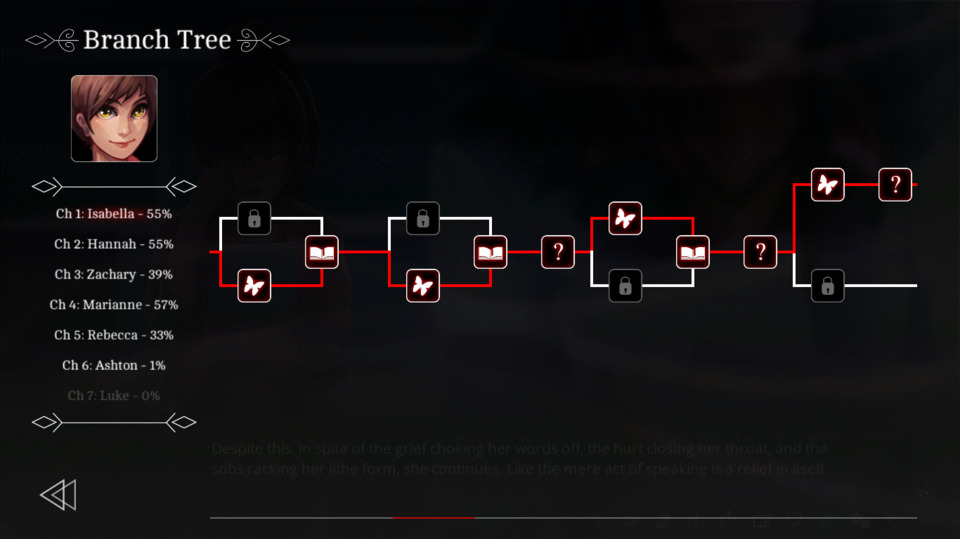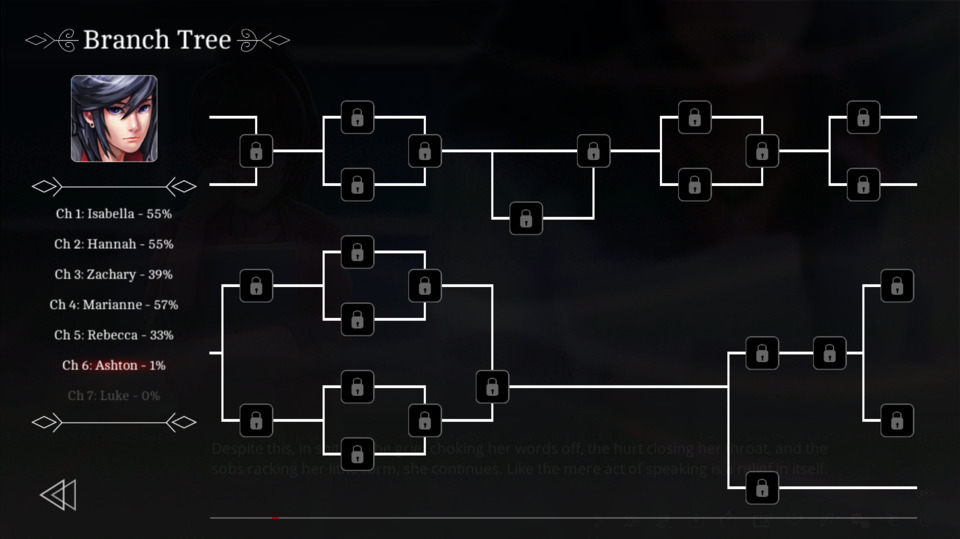VN-ese Waltz: October - The Letter
By Mento 1 Comments
Decided to spend the second half of 2021 checking out some renowned visual novels. Sometimes my ideas aren't any more elaborate than that. I've tried to discuss the following games in as spoiler-free a manner as possible, with a very spoilerish section at the end for my final thoughts on where the story goes.

Well, it's Halloween-adjacent, so I figured I should play the spookiest visual novel I happened to have on me. The Letter bucks a trend I established early on with this series: my intent was to get a working knowledge of traditional Japanese VNs before I could appreciate what the western takes were doing to subvert the formula (say, with Doki Doki Literature Club's senpai slaughterfest) but the ones I've chosen so far are already fairly distinctive in their approaches. Raging Loop, another VN I could've played around this frighteningly festive time, repurposed an elaborate variant of the social deduction game Werewolf as its narrative basis and layered on a time-looping story, neither of which seem particularly common to the VN genre. What sets The Letter apart, however, is its country of origin: the not-so-adjacent nation of The Philippines, which brought to the world such wonders as the yo-yo, adobo, and Mr. Jan Ochoa.
That said, there isn't a huge amount of Filipino culture on display in The Letter: rather, the developers sought to create a more traditional western horror story by setting the game in a haunted mansion in the UK, albeit with a diverse cast: there's a Filipina protagonist, or at least the first of many protagonists, as well as an African-American and a Japanese-American along with the more expected Irish, Scottish, and English nationals. (The ghost, meanwhile, is not Japanese but sure does look like the type of yurei so beloved of J-Horror movies like The Ring or Ju-On: The Grudge.) The story is broken up in such a way that seven major characters each have their own routes, with each following one after the other in a particular order to reveal pertinent information at the right intervals. Chronologically, a character's story will often start earlier than when the previous viewpoint character's arc ended, if only to establish some necessary backstory or motivations. This also means that many scenes that involve multiple viewpoint characters are skipped on subsequent routes, though you'll occasionally see one play out with the other character's internal thoughts instead - possibly providing a quite different context to their words compared to how the original viewpoint character perceived them. A cute little feature of this viewpoint switching is how character names will change to reflect relationships: someone who is currently a stranger might be referred to as "tall man," while the socialite and second viewpoint character Hannah Wright has a bad habit of getting peoples' names slightly wrong. You'll also get a minor info dump about each cast member in the game's "profiles" tab, but only once they've become a viewpoint character: the game uses this to its advantage, giving the most suspicious or mysterious members of the cast (though not necessarily the antagonists) the privilege of being the final viewpoint characters to maintain that mystique for as long as possible.
The structure of the game is impressive, in the sense that there are a lot of decisions you can make that have far-reaching effects, even if it's as minor as how you chose to react to another character's witticism or whether or not you told them something potentially unhelpful. This might slightly alter the dialogue in a later exchange, or completely change the arc of a different character's route. This system is both extremely extensive in its branching and a little intimidating if you're the type, like I am, to play visual novels with the goal of seeing every route play out. It's far more elaborate than, say, the aforementioned Raging Loop where every decision had an immediate effect to the story and the branches were relatively minor, or even a game like Our World is Ended, where making decisions that increased affinity towards specific characters (a system The Letter also shares) affected the ending you would get. In The Letter, there's an alternative reaction for almost every decision you might make, in addition to relationship-specific endings. You can even have characters killed off during their arcs to see what might occur in someone else's that follows (as opposed to the non-canon failstate deaths, which requires you reset to just before the game over - a similar structure to Telltale's games where deaths are either treated as plot-crucial or are quickly reversed due to being the result of player error). Pivotal moments like these have to happen late in the game's overall timeline for obvious reasons - no having a character killed only for them to show up later - but I have been morbidly curious to leave characters to their grisly fates to see how the rest of the cast would react.
Speaking of, I should probably talk about the plot of this game. The Letter begins with rookie estate agent Isabella Santos finding the titular document while checking over a cursed mansion her realtor is desperate to sell. An ominous chain letter written in blood, it inadvertently falls into the hands of six other people: Hannah and Luke Wright, the wealthy couple looking to buy the mansion; Marianne McCollough, the professional interior decorator the Wrights hired in haste to begin planning out their new home; and Isabella's three closest friends Rebecca Gales (a schoolteacher), Zachary Steele (a freelance photographer and film director), and Ashton Frey (a detective inspector). The game then follows each of the seven of them on the days before and after they read the letter, as each begins to be stalked by a malign spirit along with everyone else attached to the mansion's recent renovation and sale. It is a fairly typical ghost story told in a mostly atypical way, offering multiple viewpoints with differing amounts of information on the mansion, its new occupants, and the other accursed letter readers, along with their own inner demons and past tragedies that only make themselves known when you assume that character and have access to their interior monologues. The cool and stylish Marianne, for instance, is a picture of professionalism to every prior viewpoint character as that is the way she chooses to present herself around others; it's only when you reach her chapter you realize that she's a bit more of a disaster (and is a closet geek to boot). The ghost curse narrative and the slow "trail of breadcrumbs" method it reaches its climax is less essential to the game's flow than the player jumping from character to character, understanding how each one sees the world and how their hitherto perceived role in the story is much removed from the actual truth, and observing how the domino effect of their earlier decisions causes such massive branching later on leaving them to wonder what might have happened differently, and how those different outcomes might be triggered. It's going to be a real mess to navigate all those flowcharts later, if I ever get around to it (fortunately, like most visual novels, you have the option to skip previously read dialogue on repeat playthroughs).


I'm enjoying this game quite a bit, even if I see a headache on the horizon to get the most out of all those branches, and it's surprising that it's the studio's first project. It's much more elaborate and confident than many of the full-price VNs I've played so far, if not quite as engrossing or original. However, what strengths it has extend beyond simple storytelling and complex flowchart structures: the game's art style is exceptional if a bit Disney-esque, as well as the completely different art style it uses for its journal entries which look more like traditional manga, but more striking than those is how smooth and expressive the animations can be, normally utilized whenever a character is talking or gesturing or shrugging or sighing. There's sometimes a bit of a delay as the arms vanish and reappear in new positions that can be a little off-putting to watch, but the animation is best employed when the game is trying to spook you with a sudden ghost attack: I didn't think you could really do jumpscares in a visual novel where you have to click each time to reach the next dialogue box, but the game pulls off some pretty effective ones. In terms of typos, there's quite a few but at a rate of around 1 per every 100 words, which ratio-wise is probably close enough to my own output that I can't really grumble (and I'm ostensibly a native English speaker). Some mistakes are evidently the result of not quite understanding certain English idioms and expressions rather than simple careless spelling errors: it makes me think that the localization was probably handled in-house. Either way, the script is overall decent even if not all of its interludes and asides feel all that impactful. The voice acting isn't bad either: some of the British accents are a bit more of a stretch than others, but I respect the attempt. Last, there are these QTEs whenever the ghostly antagonist decides to get all grabby that don't really add too much but can be mitigated by playing on the easier difficulty setting or skipped altogether. The violence and gore can be... moderate, though rarely overwhelming. The grislier stuff it tends to leave to your imagination, though suffice it to say the content warnings are there for a reason.
At this point I usually follow these VN reviews with a spoiler-blocked breakdown of the story and where it ends up for the sake of fully comprehensive coverage... but I'll be skipping that step this time because I haven't actually finished the game yet: the later chapters are considerably longer than the previous ones, as all the pieces you set up earlier fall into place and you settle in for the conclusion your actions have earned you. Instead, I'll provide that breakdown when I cover the game again for this month's Dredge of Seventeen entry: turns out The Letter is a 2017 game as well, so I'm conveniently double-dipping with my features this time. (I'll link to it here when I've published it, hopefully sometime next week.)
